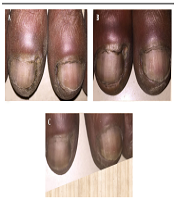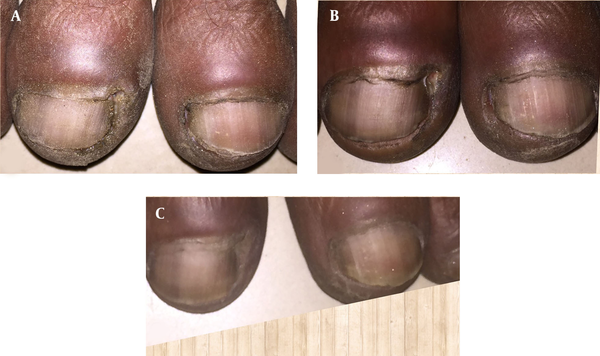Dear Editor,
Chronic recalcitrant paronychia is a multifactorial inflammatory disorder of the nail folds, caused by frequent exposure to water, irritants, and allergens. It causes swelling and fibrosis of the proximal nail folds as well as cuticle damage. In this regard, the chronicity of the lesions may persist despite medical treatment. Surgical techniques such as the en bloc excision of the proximal nail fold or epynychial marsupialization, with or without nail plate removal, are frequently used to treat such lesions (1, 2). In this case, we aimed to treat a nondiabetic patient with chronic proximal lateral paronychia (Retroparonychia), who had mucopurulent discharge from the sinuses of the lateral proximal nail unit and was resistant to medical treatment.
A 55-year-old nondiabetic patient referred to the clinic with a six-month history of chronic discharging toenail paronychia with proximal nail fold swelling and a healthy cuticle and nail gutter. On his first visit, this patient was prescribed oral antibiotics for one week and topical antibiotics for four weeks. The patient was given cyanoacrylate glue when he failed to respond to the medical treatment (Figure 1A). For 12 weeks, the glue was applied once a week, and touch-ups were done by the patient at home. After six weeks, the lesions were partially dried and healed at a few sites (Figure 1B) and were recovered in about 12 weeks (Figure 1C). There were no side effects and no recurrence during the follow-up. As monomers, there were 2-octyl-cyanoacrylate molecules. When exposed to moisture or exudate, 2-octyl cyanoacrylate polymerizes quickly, absorbs moisture, makes the site dry, binds to the superficial epithelium, and forms a water-tight barrier at the site, thereby allowing wound healing. It has an inherent antimicrobial activity and a mechanical barrier preventing organisms, allegens, irritants and water from being entered. Accordingly, the glue can be an appropriate and effective topical sealant agent for treating chronic paronychia with continuous mucopurulent discharge caused by the sinus of the nail unit (Retroparonychia). Similar case studies are recommended to examine a large number of cases to demonstrate its efficacy.

